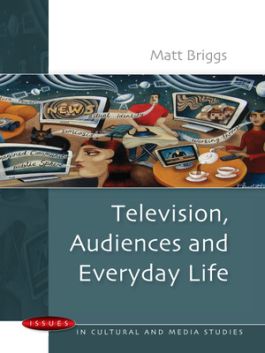Television, Audiences and Everyday Life
- Access the eBook anytime, anywhere: online or offline
- Create notes, flashcards and make annotations while you study
- Full searchable content: quickly find the answers you are looking for
Chapter One: Television, News & the Public Sphere
• Questions of Method
• Public Sphere
• Working Through
• The Embedded Audience
• Semiosis & Everyday Life
• Rethinking Decoding: Modalities of Response
• What is an Audience?
Chapter Two: Reality Television, Audiences & Ethics
• Modalities of Response: Game Play & Authenticity
• Working Through: Dramatizing Morality
• Lifestyle Programming: Identity and an ‘Ethics of Care’
• Talk Shows & Everyday Life
• Conclusion
Chapter Three: Soap Opera & Play
• Play & Ethics
• Soap Opera & the Carnivalesque
• Working Through: Soap Opera & Gossip
• A Ludic Orientation
• Personalisation, Character Interpretation & Speculation
• Working Through: Identity
• Play, Fantasy & Emotional Realism
• Conclusion
Chapter Four: Television & Domestic Space
• The Social Uses of Television
• Environment
• Regulation
• Communication Facilitation
• Affiliation & Avoidance
• Social Learning
• Competence and Dominance
• Dailiness
• Dailiness and the Elderly
• Domestic Time and Interior Space
• Conclusion
Chapter Five: Television, Identity & Global Audiences
• Imagined Communities: Nostalgia and Self-Reflexivity
• Thinking Across Spaces: Demythologisation
• Dailiness & the Public Sphere
• Public Sphericules & Community Spaces
• Identity and the Care of the Self
• News, Semiosis and Global Space
• Conclusion
Conclusion: Television & Ethics
• Ethics
• Semiosis and Everyday Life
• Media Ethics: Where do we go from here?
Glossary
Bibliography
Television, Audiences and Everyday Life draws on an extensive body of audience research to get behind this seemingly simple activity. Written in a clear and accessible style, key audience studies are presented in ways that illuminate critical debates and concepts in cultural and media studies.
Key topics and case studies include:
News, debate and the pubic sphereReality television, talk shows and media ethics
Soap opera, play and gossip
The uses of television in the home
Television, identity and globalization
Textual analysis, discourse and semiotics
Each chapter makes a compelling case for the importance of audience research in our thinking about television texts. The case studies introduce important new terms in the study of television, such as play, semiosis and modality, while also throwing new light on familiar terms, such as decoding, ideology and the public sphere.
Television, Audiences and Everyday Life is essential reading for undergraduate students on media, cultural studies and sociology courses, or anybody who wants to understand television, its genres, and their place in everyday life.

